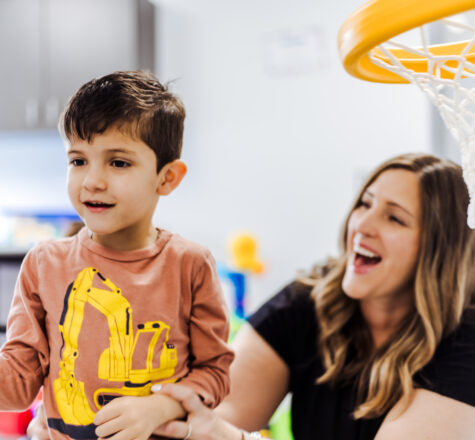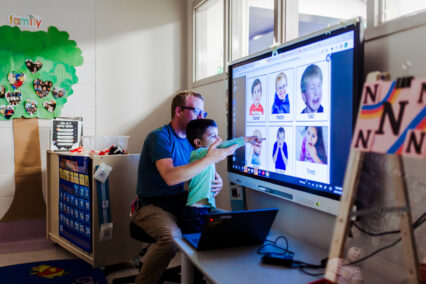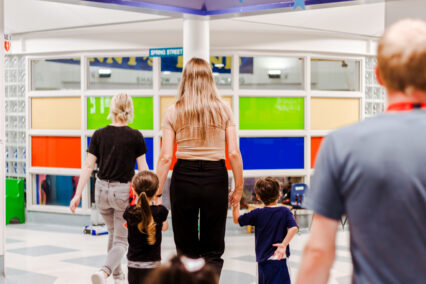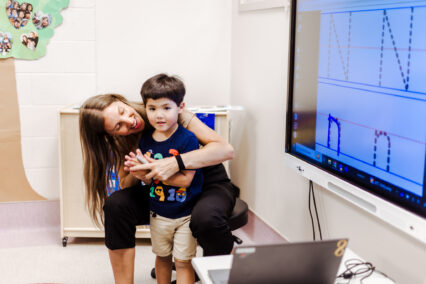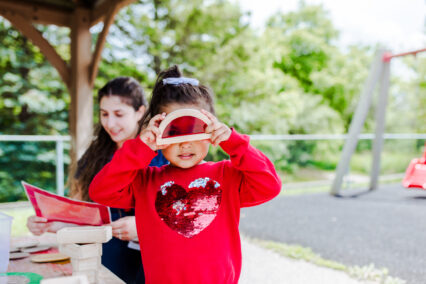When a child faces communication and swallowing difficulties, it can affect their functioning and participation in various environments including home, school and community. KidsAbility’s Speech-Language Pathologists (SLPs) help families to develop their child’s communication and swallowing abilities. Services are offered virtually or in person.
SLPs help children engage, interact, and play with family and friends, using words, signs, gestures, or specialized devices. They also address challenges like understanding language, stuttering, pronunciation, feeding, swallowing, voice and resonance. By working with the family first to identify the challenge, along with one-on-one, group, or coaching sessions, we will help each child and family with strategies and support to overcome it.
Assessment
If you’re concerned about your child’s speech, call KidsAbility for an assessment. Our Speech-Language Pathologists (SLPs) will partner with you to evaluate your child’s communication skills and plan next steps for speech and language development.
During the assessment, you will share your insights on your child’s daily routines, relationships, feelings, and challenges. SLPs use various assessment methods tailored to your child’s age and needs. Most assessments involve interviews, interaction and play, checklists, and engaging activities. We will explore things like:
- How does your child communicate?
- Gestures or actions
- Sounds and partial words
- Mispronounced words or phrases
- How well does your child understand language?
- Recognizing names of things
- Following directions
- Repeating, pointing, or gesturing
- How well do you understand your child’s communication?
- Are sounds dropped, altered, or substituted?
What Service Looks Like
If speech and language therapy is recommended, our SLPs and Communicative Disorders Assistants (CDAs) will work with you to:
- Expand your knowledge
- Discover effective intervention strategies
- Adjust to meet the specific needs of your child
- Support a positive attitude
Intervention is based on continuous assessment, taking into account the input from other professionals and your child’s response over time. At KidsAbility, we personalize the approach to match your child’s characteristics and family dynamics, potentially including:
- Parent Training: Interactive sessions with other parents.
- Group Therapy: Peer learning environment.
- Individual Therapy: One-on-one sessions.
- Home Programming: Daily practice.
- Consultation: Support for caregivers, child care providers, and more.
Referrals should be made any time if your child:
- Has had a specific medical diagnosis indicating long term developmental issues
- Does not share interest with others (joint attention)
- Lacks eye contact or social engagement
- Plays in an unusual way (e.g. repetitive or obsessive play, wanting to play alone)
- Stutters (i.e., Repeats sounds or words, holds sounds or has trouble getting a word out)
- Has an unusual voice quality (hoarse, nasal, etc.)
- Has a cleft lip and/or palate (repaired or waiting for repair)
- Has permanent hearing loss
- Has feeding issues, such as:
- Risk of aspiration:
- History of illness (chest infections, asthmas, bronchitis, pneumonia, fevers/ colds)
- Frequent or occasional choking or vomiting on food or liquid
- Frequent or occasional coughing or gagging during and/or after meals
- Is primarily tube-fed but is starting to explore oral feeding with the support/consent of their physician
- Is delayed in how they manage solid foods (e.g. swallowing foods whole with no chewing, sucking then swallowing to manage soft foods)
- Takes more than hour to eat a meal
- Has feeding issues that mean the child is not getting enough food, and is losing weight and/or at risk for hospitalization
Remember that early intervention helps with various challenges and therapy goals, including language delays, speech difficulties, social interactions, play skills, eating skills and more, improving readiness for school and overall quality of life.
Milestones
What Should My Child Be Doing?
Here are some things that your child should be doing every day:
- looks to sounds and voices
- is surprised by loud noises
- cries in many ways when hungry, tired or in pain
- smiles and laughs when you do
- tries to get your attention
- reaches for things and people makes lots of sounds – by 6 months makes sounds like “ma”, “da”, “ba”
What Should My Child Be Doing?
Here are some things that your child should be doing every day:
- makes lots of sounds every day like “bababa”, “duh duh duh”
- uses their voice to get your attention
- looks when you call their name
- hears sounds like as the dog barking, the phone ringing
- looks at a toy, then looks back to you when they want the toy
- likes being with people likes to play peek-a-boo
What Should My Child Be Doing?
Here are some things that your child should be doing every day:
- starts to know the names of common things (points to the ball when they hear you say “ball”)
- follows simple directions (“sit down”)
- looks to where you point
- starts to wave, point, lifts arms to be picked up, shakes their head for “no”
- copies the actions and sounds that you make
- gets your attention using sounds and actions while looking at your eyes
- says 3 or more words
- puts lots of sounds together as if they are trying to talk likes to look at books
What Should My Child Be Doing?
Here are some things that your child should be doing every day:
- can show that they know words like
- on (Put your cup on the table)
- off (Turn the light off)
- in (Your foot goes in your shoe)
- out (Take the book out of the bag)
- can point to 5 body parts when you ask them
- can say 20 or more words
- the words may not sound clear (says “buh” for “bus”)
- knows more words than they can say
- answers simple questions with a word or an action (“Where’s the ball? – may go look for it, point to it, or say “ball”)
- does simple pretend things like talking on the phone, eating toy food, putting a doll to bed
- uses the sounds that are easy to make (m, p, b, d, w, h)
- likes when you
- look at books
- read simple stories with you can point to some pictures in a book
What Should My Child Be Doing?
Here are some things that your child should be follows directions with 2 parts (ex. Get your ball and show it to Grandma”)
- says 100 or more words
- says words like “you, me, mine”
- says 2 words together (Mommy up, more ball)
- people can understand what your child says at least half of the time
- likes to be with other children and tries to copy what they say and do
- holds books the right way and turns the pages
- pretends to read doing every day:
What Should My Child Be Doing?
Here are some things that your child should be doing every day:
- knows the meaning of
- big
- little
- more
- a lot
- a little bit
- begins to add endings to words like
- “running
- balls
- mommy’s hat
- says 350 words or more and learns new words every week
- uses action words like “running, spill, playing”
- uses easy sounds at the start and end of simple words
- tries to say words that have 2 to 3 parts – “banana may sound like “nana” and water may sound like “wawa”
- takes short turns with other children but still has trouble sharing
- is worried when another child is hurt or sad
- pretend play has many steps (feeds a doll and puts her to sleep, fills toy car with gas and drives it away)
- recalls and understands stories and songs that they know well
What Should My Child Be Doing?
Here are some things that your child should be doing every day:
- understands and asks questions like
- “Where is your coat?
- Who’s that?
- What is soap for?
- says sentences with 5 or more words
- can tell about things they have done or tell a simple story
- people other than you can understand what they are saying most of the time
- enjoys other children and plays more with them
- pretend play follows a story (drives the car, crashes the car, fixes the car, drives the car again know that written words mean something even though they cannot read (name of the cereal on the box)
What Should My Child Be Doing?
Here are some things that your child should be doing every day:
- follows directions with 3 parts (first get some paper, then draw a picture, last give it to mom)
- sentences sound like adult speech
- tells stories with a clear start, middle and end
- uses their words to try to solve problems
- lots of imagination when playing
- most people can understand them almost all of the time
- can make up simple rhymes (cat-bat)
- knows some of the sounds letters make (T says “tuh”)
What Should My Child Be Doing?
Here are some things that your child should be doing every day:
- understands group directions (“All the boys get a toy”)
- understands “if…then” directions (“If you’re wearing runners, then line up for gym”
- tells long stories
- speaks about past, present, and future events
- uses long sentences (puts 5 to 8 words together)
- uses almost all of the sounds of their language correctly
- knows the letters of the alphabet
- can sometimes tell you what sound starts a word (“Ball starts with the ‘buh’ sound”)
- makes friends, and likes to make their friends happy
- plays in groups of 2-5 friends Speech and Language
